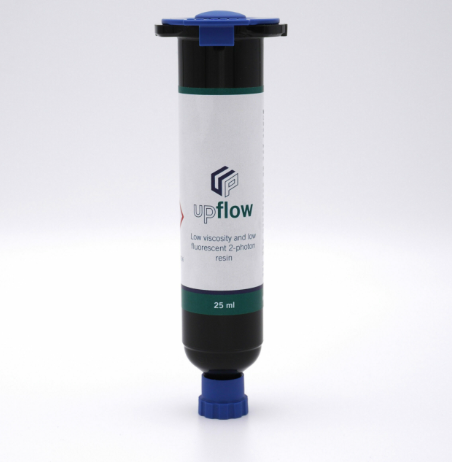High-resolution micro-scale 3D printing company UpNano GmbH has announced the development of UpFlow, a photopolymerizing material.
This material enables rapid and precise 3D printing of micro-environments for a new type of dynamic cell culture. Developed by Australian IVF specialist Fertilis, it provides a more controlled and less variable environment for embryos prior to implantation and more closely resembles the human body than other products that are currently available. Utilizing an UpNano NanoOne 2PP 3D printer allows for a 30-40% reduction in implantation cycles, which are commonly required to become pregnant, saving patients’ emotional and financial pain.
“Our device allows fertilization, embryo culture, and embryo cryopreservation to occur in the one structure – no more moving embryos around by hand. This, in fact, increases the success rate significantly and reduces time, costs, and stress for the parents,” said Marty Gauvin, CEO of Fertilis.

How this novel technology can ease the IVF process?
According to Fertilis, in vitro fertilization (IVF) is a stressful time for both parents and embryos. To keep them safe and healthy during the pre-implantation phase, they must be exposed to constantly changing conditions. This not only causes significant stress but also increases the risk of failure, necessitating repeated IVF cycles. Fertilis developed and patented a new environment for the critical life phase between fertilization and implantation of the embryo in order to reduce stress on the embryo and increase IVF success rates. This “first-of-its-kind” 3D printed micro-device has features 0.05mm in diameter and enables IVF professionals to accurately control and monitor the fertilized egg culturing process, eradicating the need for IVF professionals to move cells between Petri dishes.
“UpFlow offers a lower viscosity than any other 2PP material with comparable biocompatibility. This allows for far superior post-production processing, especially the flushing of the very fine channels in order to remove unpolymerized material and ensure the reproducibility of structural elements,” said Denise Hirner, Chief Operating Officer and Co-founder of UpNano.
UpNano accomplished this by selecting specific base resins for the UpFlow material that maintain the low viscosity until a final UV exposure solidifies the material and makes it ready for use. Other benefits of the material include its high optical transparency, which makes it ideal for microscopic inspections of incubated embryos, and its very low autofluorescence.
Fertilis employs UpFlow combined with a NanoOne printer which was recently supplied to the Australian National Fabrication Facility (ANFF) at the University of South Australia. This printer not only enhances the quality of the 3D-printed micro-device for embryo incubation but also the production speed. CEO of Fertilis further explained, “Previously, the 3D printing of our microfluidic devices took a full fortnight. Now, 4 hours only. That is an exceptional acceleration of the production process. And, best of it all, using UpFlow results in a better-quality product than achieved before.”
Using a NanoOne also allows for maximum advantage of its adaptive resolution technology. This can change the focus width of the laser beam while printing. Larger and smaller features can be printed in one pass, improving production time and quality. UpNano claims that the development of UpFlow demonstrates the “enormous potential” of 2PP 3D printing for cell and medical research. UpNano demonstrated this by introducing X Hydrobio INX U200, the only commercially available resin that enables embedding living cells directly from a culture dish within highly precise 3D printed structures for biological applications.

Additive manufacturing scaling the biological sector
Recently, CollPlant, a 3D bioprinting specialist, expanded its material portfolio with the addition of a new bio-ink. CollPlant’s second recombinant human collagen (rhCollagen)-based material, dubbed ‘Collink.3D 90,’ is said to have improved mechanical properties that specifically target the print demands of hard and soft tissues. When compared with existing cell-culturing hydrogels, the ink is said to allow for rapid cell migration, which could make it an ideal foundation for creating regenerative medicines.
Previously, researchers from the University of British Columbia (UBC) successfully 3D bioprinted human testicular cells, which is believed to be a world first. After discovering some early signs of sperm production potential, the researchers hope to use their results to aid male infertility. Dr. Ryan Flannigan who is the study’s lead author claims that infertility affects about 15% of couples, with male factors being a contributing factor in more than half of confirmed cases. He added, “We’re 3D printing these cells into a very specific structure that mimics human anatomy, which we think is our best shot at stimulating sperm production. If successful, this could open the door to new fertility treatments for couples who currently have no other options.”
Follow this link for all the Formnext 2022 news.
To stay up to date with the latest 3D printing news, don’t forget to subscribe to the 3D Printing Industry newsletter or follow us on Twitter, or like our page on Facebook.
While you’re here, why not subscribe to our Youtube channel? Featuring discussion, debriefs, video shorts, and webinar replays.
Are you looking for a job in the additive manufacturing industry? Visit 3D Printing Jobs for a selection of roles in the industry.
Feature image shows UpNano’s resin UpFlow. Image via UpNano.


